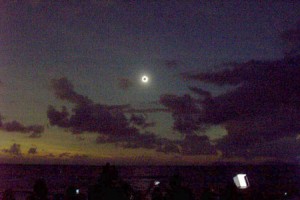
By Dr. Alan Hale
Faculty Member, Space Studies at American Public University
On Wednesday morning, November 14, 2012, the path of a total solar eclipse crossed over portions of northern Australia, including directly over the city of Cairns, Queensland. As a result of a grant from American Public University, I was able to travel to Cairns in an attempt to view this eclipse and carry out some scientific observations.
In northern Queensland, November is usually a transition period between the dry winter season and the wet summer season, and thus weather prospects for the eclipse were always somewhat problematic. During most of the days prior to the eclipse, rain occurred off and on each day, and the forecasts for eclipse day did in fact indicate a strong likelihood of clouds and rain.
I set up to observe the eclipse along the beach at Palm Cove, approximately 20 kilometers north of Cairns. I joined members of the Astronomical Association of Queensland and employees of the Far North Queensland and Region of the Australian Department of Education, Training and Employment, as well as Tourism Tropical North Queensland. Totality was to occur approximately one hour after sunrise, and initially a thick band of clouds along the eastern horizon prevented all but brief and occasional glimpses of the partial phases of the eclipse. However, the clouds in the Sun’s vicinity broke just a few minutes before totality, and those of us gathered along the beach at Palm Cove were able to witness the complete two minutes of the full total eclipse.
The research project was an attempt to observe any comets that might be near the Sun during totality — in particular, a certain class of comets known as “Kreutz sungrazers.” Such comets tend to arrive in “clusters” of several over an interval of approximately one decade, and have been among the brightest comets ever seen in history. A few years ago two astronomers at the Jet Propulsion Laboratory in Pasadena, California predicted that a new such “cluster” would be appearing within the next one to two decades, and the first apparent member of this “cluster,” Comet Lovejoy C/2011 W3, was a spectacular object as seen from the southern hemisphere near the end of 2011.
Meanwhile, two coronagraphs aboard the joint NASA-ESA Solar and Heliospheric Observatory (SOHO) spacecraft have detected over 2,000 tiny Kreutz sungrazers since its launch in late 1995. If one of these comets were to be near the Sun during totality, ground-based observations of it would be very helpful in calibrating the SOHO dataset with the ground-based observations of Kreutz sungrazers and other comets. I collaborated with a comet researcher associated with the SOHO mission who could provide key information, including orbital and positional information, of any such comets that might appear.
For such a project to succeed, not only does the sky need to be clear during the eclipse, but the timing also has to be just right (i.e., one of these comets needs to be near the Sun at just the right time). I knew that the chances of success were quite slim. Unfortunately, according to the SOHO data there were no comets near the Sun at the time of totality and the project didn’t yield the results we hoped to obtain. As it turns out, a comet did begin to appear in the field-of-view of the SOHO coronagraphs approximately one hour after totality at Cairns, but in actuality, this object would have needed to appear about a day earlier for us to have any realistic chance of detecting it from the ground during totality.
I also participated in setting up a webcast of the eclipse that was hosted by the Astronomical Society of Queensland and Tourism Tropical North Queensland, which provided the feed for the “official” NASA eclipse webcast. In the days prior to the eclipse I spoke to students and teachers at various schools in the Cairns area, specifically Cairns West State School, Edge Hill State School, Cairns State High School, and Innisfail College. I also had the opportunity to visit an Astronomy Education Workshop at Tinaroo Lake Resort wherein I saw my co-discoverer (Thomas Bopp) for the first time in fourteen years and met Professor Graeme White, co-discoverer of a Kreutz sungrazing comet in 1970.
About the Author:
Alan Hale’s research interests include the search for planets beyond the solar system, including those which might have favorable environments for life; stars like the Sun; minor bodies in the solar system, especially comets and near-Earth asteroids; and advocacy of spaceflight. He is primarily known for his work with comets, which has included his discovery of Comet Hale-Bopp in 1995 and his participation in the International Halley Watch during the return of Halley’s Comet in 1986. In recent years he has worked to increase scientific collaboration between the U.S. and other nations, including Iran (wherein he led two delegations of American scientists, students, and educators to that country, one of these efforts being held in conjunction with the August 11, 1999 total solar eclipse), Zimbabwe, and Lebanon. As a result of these efforts in 2009 he was named the New Mexico state finalist in that year’s “Above and Beyond” Awards program (the civilian equivalent of the Congressional Medal of Honor).
Comments are closed.